Ready to see the market clearly?
Sign up now and make smarter trades today
Trading Basics
December 25, 2024
SHARE
Making Sense of Support and Resistance: How Price Barriers Impact Trading Decisions
You live in Japan and don’t know Japanese. If you are not open to learning
Japanese, will you be able to set up a profitable business? Trading isn’t
just about buying low and selling high; it’s about understanding the
language of the market.
Through this article, you will understand how support and resistance levels
act as your biggest allies and let you talk with the market. Both these
levels are psychological and technical, defining where the market may pause,
reverse, or surge.
We’ll also guide you on how to act against overreliance and how advanced
tools like Bookmap, uncover the secrets of market liquidity, volume, and
real-time order flow. Let’s get started.
The Basics of Support and Resistance
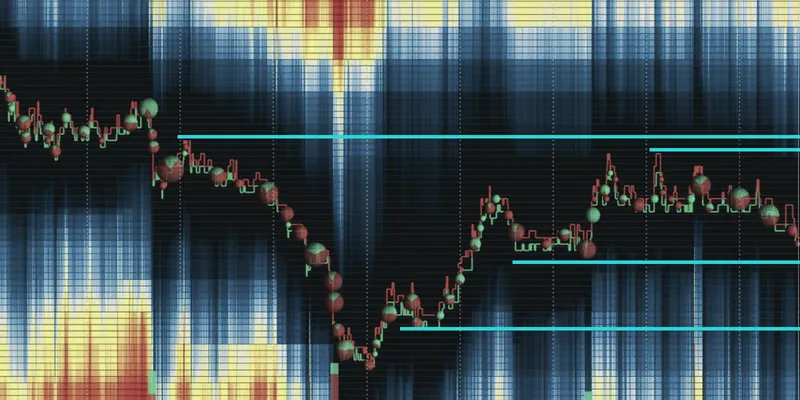
Support and resistance levels are associated with supply and demand
dynamics. Both of them play a crucial role in determining price movements.
See the table below:
|
Level |
Meaning |
Correlation with Demand |
Visualizing with Tools |
|
Support |
Support is a price level at which an asset tends to stop |
Support levels indicate a strong demand for the asset. |
Market analysis tools like Bookmap have features such
These visually represent support levels by using colors |
|
Resistance |
Resistance is a price level at which an asset tends to
|
Resistance levels indicate a strong supply of the asset. |
Similar to support, using Bookmap, you can visualize |
How These Levels Help Traders
The interaction between support and resistance levels is critical for
traders. Here’s how they are commonly used:
-
Buy at Support:
-
Traders buy assets when they approach support levels
-
They believe that demand will push the price higher from that
point.
-
-
Sell at Resistance:
-
Traders sell assets at resistance levels.
-
They believe the price to reverse due to the supply in that
area.
-
What is Support?
As mentioned earlier, support refers to a specific price level on a stock,
commodity, or any financial asset chart where a downtrend is expected to
pause or even reverse due to a concentration of demand.
You can think of support as a safety net or floor.
-
Think of a tightrope walker walking on a high wire between two
buildings. -
They know that if they slip, there’s a safety net or a floor a few
feet below to catch them. -
This net or floor represents a level of support in the financial
markets. -
It’s the point at which the asset’s price tends to stop falling,
just like the safety net stops the tightrope walker from falling too
far.
Let’s understand through a hypothetical example.
Company X is currently trading at $50 per share. Over the past few months,
the stock has been in a downtrend. However, at the $40 price level, it has
consistently shown signs of support. Every time the price nears $40, it
either bounces back up or at least slows down its descent. This $40 price
level can be considered a support level.
Why do buyers jump in at certain levels, creating support?
The psychology behind the support is driven by several factors, such as:
-
Perceived Value:
-
When the price of an asset drops to a certain level, buyers
believe it’s a good deal. -
They perceive the asset as undervalued, and this perception
encourages them to buy.
-
-
Emotional Reactions:
-
Investors’ emotions play a significant role.
-
When an asset’s price falls and approaches a support level:
-
Fear of missing out (FOMO) or the desire to avoid losses
drives more buyers to enter the market. -
This surge in demand leads to creating a support level.
-
-
-
Stop-Loss Orders:
-
Many traders place stop-loss orders just below key support
levels. -
When these orders are triggered, they can lead to a surge in
buying as traders try to limit their losses.
-
What is Resistance?
Resistance represents a specific price level on a stock, commodity, or any
financial asset chart where a trend, typically an uptrend, can pause or
reverse due to an abundance of selling activity.
Think of Resistance as a Ceiling or Barrier:
-
Resistance can be thought of as a price level that acts like a
ceiling or barrier, preventing the asset’s price from rising
further. -
Just as the ceiling in a room stops you from moving upward,
resistance is a point on a price chart where the price struggles to
break through.
Let’s understand through a hypothetical example.
Company Y is trading at $60 per share. Over the past few months, the stock
has been in an uptrend. However, at the $70 price level, it consistently
shows signs of resistance. Whenever the price approaches $70, it tends to
slow down or even reverse. This $70 price level is a resistance level.
Why do sellers jump in at certain levels, creating resistance?
The formation of resistance is influenced by
emotions and market psychology
, including:
-
Fear of Missing Out (FOMO):
-
When the price of an asset approaches a resistance level,
traders fear missing out on potential gains. -
Additionally, they also believe that the price has reached an
overbought state. -
This perception leads to hesitation and selling at this
perceived “peak.”
-
-
Profit-Taking:
-
Investors who bought the asset at lower prices may decide to
take profits when the price nears a resistance level. -
This selling activity can act as a barrier to further price
increases.
-
-
Technical Analysis:
-
Many traders and algorithms use technical analysis to identify
resistance levels on price charts. -
When these levels are reached, it can trigger automated selling
or profit-taking actions.
-
Identifying Support and Resistance Levels
Identifying support and resistance levels is crucial. Historical price
levels help in determining these key levels. Let’s dive in further.
How to Use Historical Price Levels For Identification
Historical analysis is a three-step process. See the table below::
|
Steps |
Explanation |
|
Select a Time Frame |
Start by examining 6-month or 1-year historical price |
|
Observe Price Halts |
As you review the chart, pay close attention to price
These levels are characterized by multiple price touches
|
|
Strength in Frequency |
|
Psychological Levels
Psychological levels
play a significant role in trading and investing due to the human tendency
to gravitate towards whole numbers and round figures. These levels often act
as key points of interest in the financial markets. Let’s delve into their
significance.
Why are Round Figures Significant?
-
People are naturally drawn to round numbers because they are easy to
remember and provide a clear reference point. -
At round figures, more traders buy, sell, or take other actions.
-
Round numbers have a strong emotional impact on traders. For
example, a stock crossing $100 may trigger excitement, while failing
to break $100 may induce fear or hesitation.
Let’s understand this significance practically using examples of various
assets:
-
Bitcoin at $10,000:
-
Bitcoin’s price at $10,000 has been a significant psychological
level. -
Bitcoin has often faced strong resistance when nearing this
level. -
Traders and investors pay close attention to Bitcoin’s
performance of around $10,000 due to the emotional impact of
reaching a five-figure price. -
When Bitcoin finally broke through $10,000, it triggered
substantial buying interest, leading to further price
appreciation.
-
-
Stocks at $100:
-
In the stock market, $100 is a psychological milestone.
-
A stock approaching $100 may attract significant attention from
traders and investors. -
If the stock fails to break above $100, it can lead to
profit-taking or selling pressure.
-
-
Gold at $1,000:
-
When gold prices approach $1,000, traders closely monitor its
behavior. -
Breaking above $1,000 often leads to increased interest in gold
investments.
-
Trendlines and Moving Averages
Most traders use trendlines to identify trend direction and potential
reversal points. Whereas, moving averages are adaptable indicators that help
filter out price noise and identify trends. Let’s start by learning how to
make a trendline.
How To Draw Trendlines
Learn easily by reading this step-by-step guide:
Step 1: Identify the Trend:
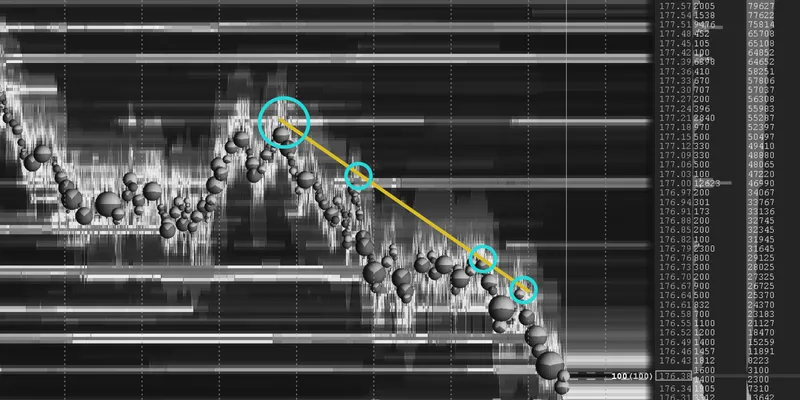
-
Start by identifying the trend you want to analyze.
-
It can be:
-
An uptrend (ascending)
-
A downtrend (descending), or
-
A sideways trend (horizontal).
-
Step 2: Select Reference Points:

|
Type of Trend |
Reference Points |
|
For an uptrend |
Look for a series of higher lows and higher highs. |
|
For a downtrend |
Look for a sequence of lower highs and lower lows. |
|
For a sideways trend |
Observe whether the price moves within a range without a |
Step 3: Draw the Trendline:
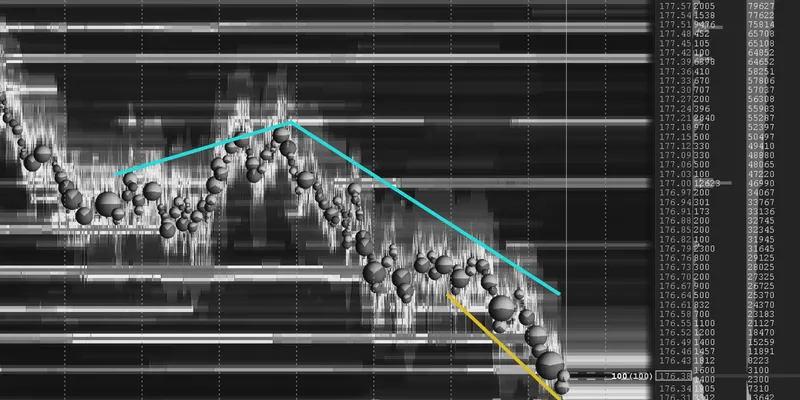
-
Use a straight line or a trendline tool on your charting software to
connect the points. -
The points to connect will depend upon the type of trend you are
observing. -
See the table below:
|
Type of Trend |
Points to Connect |
|
Uptrend |
Connect the low points |
|
Downtrend |
Connect the high points |
|
Sideways Trend |
Connect the price peaks and troughs |
Step 4: Validate the Trendline:
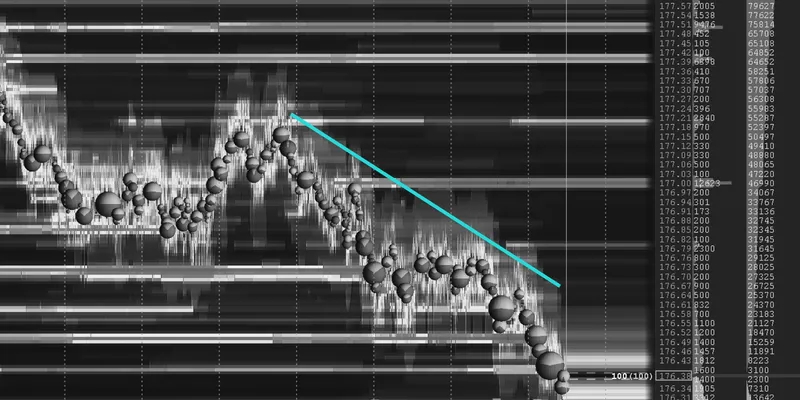
-
Ensure that the trendline touches multiple price points.
-
The more times the price respects the trendline without significant
breaches, the stronger the trendline.
How to Calculate Moving Averages
Moving averages are calculated by adding the closing prices of an asset over
a specific number of periods (e.g., days or hours) and then dividing by the
number of periods.
For example, a simple moving average (SMA) over 50 days is calculated by
summing the closing prices of the last 50 days and dividing by 50.
What are the Different Types of Moving Averages?
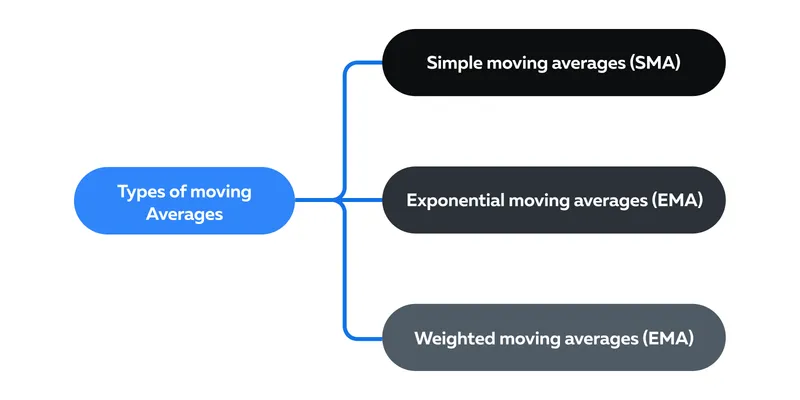
Are Moving Averages Adaptable to Price Changes?
Moving averages adapt to price changes by continuously recalculating the
average as new prices are added and old prices are dropped from the
calculation window. This adaptability helps traders identify changes in
trend direction.
For example:
|
Event |
Indication |
|
Short-term moving average (e.g., 50-day) crosses above a |
A potential uptrend |
|
Short-term moving average (e.g., 50-day) crosses below a |
A potential downtrend |
Trading Strategies Using Support and Resistance
Using support and resistance levels in trading strategies can be a powerful
tool for traders and investors. Let’s study the popular bounce and break
strategy.
The Bounce and Break Strategy
The Bounce and Break Strategy identifies:
-
Potential “bounces” off support
-
Potential “breaks” through resistance
Let’s break this down with a simple scenario:
Suppose Mr. A is analyzing the price of Stock XYZ, which has been on a
steady uptrend. He notices that the price is approaching a well-established
support level of $50. Here’s what Mr. A did before making a trading
decision:
a) Historical Observation
-
Mr. A reviewed the past price behavior of Stock XYZ and saw that it
had touched the $50 support level several times before. -
Each time it touched this level, it bounced back up.
-
So, he concluded that the $50 level was a robust support for this
stock.
b) Waiting for Confirmation
-
Mr. A wasn’t hasty. He looked for additional signs that supported
the idea of a bounce. -
He paid attention to candlestick patterns, especially those
indicating a potential bullish reversal, and he also checked for
volume confirmation.
c) Making a Trading Decision
-
After conducting his analysis, Mr. A decided to take a long (buy)
position. -
He believed that history might repeat itself, and the price would
bounce off the $50 support level.
This strategy is essentially a straightforward yet effective way for traders
seeking opportunities in the market.
How Important Is Confirmation?
There is a possibility of a false breakout in the Bounce and Break strategy.
Even if a support level has been held multiple times in the past, there is
no guarantee that it will do so in the future. Waiting for confirmation
helps reduce the risk of entering a trade just before a support level
breaks.
Also, it is always advised to rely on multiple confirmation signals before
making a trade. Traders must not solely base their decision on the
historical performance of a support level. The usage of technical analysis,
volume data, and other indicators is paramount.
Role Reversal Trades
Role reversal trades represent a price level that was:
-
Previously acting as resistance and
-
Now switches roles to become a support level, or vice versa.
Let’s understand the concept through this hypothetical scenario.
-
Bitcoin is trading below the $15,000 price level for an extended
period. -
This price level is acting as strong resistance.
-
In a recent rally, Bitcoin successfully broke through this
resistance and surged to $20,000. -
Now, Bitcoin has pulled back and is trading at around $15,000.
Why do Role Reversals Happen?
Here are some possible causes:
-
When an asset breaks through a significant resistance level, it
triggers excitement and leads to increased buying interest and
demand. -
After the resistance is broken and the price pulls back to that
level, traders who missed the initial breakout see it as a second
chance. -
Those who sold at the resistance level may experience “seller’s
remorse” when they see the price continuing to rise after the
breakout. Some of these sellers may buy back in at the prior
resistance level, further supporting the idea that it now acts as a
support.
Leverage Bookmap to Enhance S/R Analysis
Bookmap is a platform with advanced visualization features that can provide
traders with a unique perspective on S/R zones and market liquidity. Here’s
how Bookmap enhances S/R analysis:
a) Advanced Visualization with Heatmap:
Bookmap’s heatmap provides a real-time view of the order book. It shows the
concentration of buy and sell orders at different price levels.
How do traders use the heatmap to quickly identify potential S/R zones?
-
The heatmap’s color coding helps traders visualize liquidity.
-
This makes it easier to spot areas with strong S/R potential.
b) Using Volume Dots:
Bookmap’s Volume Dots display real-time trading activity. These dots
indicate when trades occur and the volume associated with each trade.
Let’s understand with an example.
-
Mr. X is analyzing Bitcoin’s price.
-
The price approached a support level of $40,000.
-
He noticed a cluster of large buy Volume Dots appearing just above
$40,000. -
This signals strong buying interest, reinforcing the strength of the
support level.
Conversely, a cluster of large sell Volume Dots near a resistance level
would suggest strong selling interest.
c) Historical Liquidity Analysis:
Bookmap also allows traders to review historical liquidity data. By
observing the heatmap over time, traders can identify areas where high
liquidity has persisted. These areas often correspond to strong S/R zones
that are respected by the market.
d) Real-Time Order Flow Changes:
Bookmap displays real-time order flow changes. Traders can easily see:
-
When large orders enter the market or
-
When a previously strong S/R level experiences a sudden shift in
liquidity.
Common Mistakes and How to Avoid Them
Traders must understand the common mistakes and learn how to avoid them.
Here are the two most common mistakes that most traders make:
Mistake 1: Over-reliance on Support and Resistance
Let’s understand through a scenario.
-
A trader identifies a robust support level at $50 for a stock.
They’re so confident in this support level that they place a
substantial buy order, expecting a bounce. -
However, the market sentiment changes due to unforeseen news, and
the stock breaks below $50, leading to a significant loss for the
trader.
How to Avoid It
-
Don’t treat Support and Resistance (S/R) levels as absolute or
guaranteed, especially in volatile markets or when unforeseen events
occur. -
Always use other technical indicators and confirmations. Don’t rely
solely on S/R levels. -
Always use stop-loss orders to manage risk.
Mistake 2: Ignoring Volume
Let’s understand through a scenario.
-
A trader observes a cryptocurrency approaching a resistance level at
$10,000. -
The price appears to break above this resistance, and the trader
enters a long position. -
However, they fail to notice that the break occurred with very low
trading volume. -
The price quickly reverses, and the trader experiences losses.
How to Avoid It
-
Always pay attention to trading volume when analyzing S/R breaks.
-
Combine volume analysis with other technical indicators to confirm
S/R breaks.
Conclusion
Support and Resistance (S/R) levels can certainly help you understand the
language of the market. Be it your business venture in Japan, or your trades
in the market, you can enjoy both only after making informed decisions.
S/R levels provide critical insights into market dynamics and help traders
identify potential reversal points. Advanced market analysis tools, like
Bookmap, enhance S/R analysis through heatmaps, volume dots, display of
real-time order flow changes, and more.
Ready to experience the power of advanced visualization in identifying
Support and Resistance zones? Dive deeper and gain an edge in your trading
decisions with Bookmap.
Sign up now
and elevate your trading strategy.
